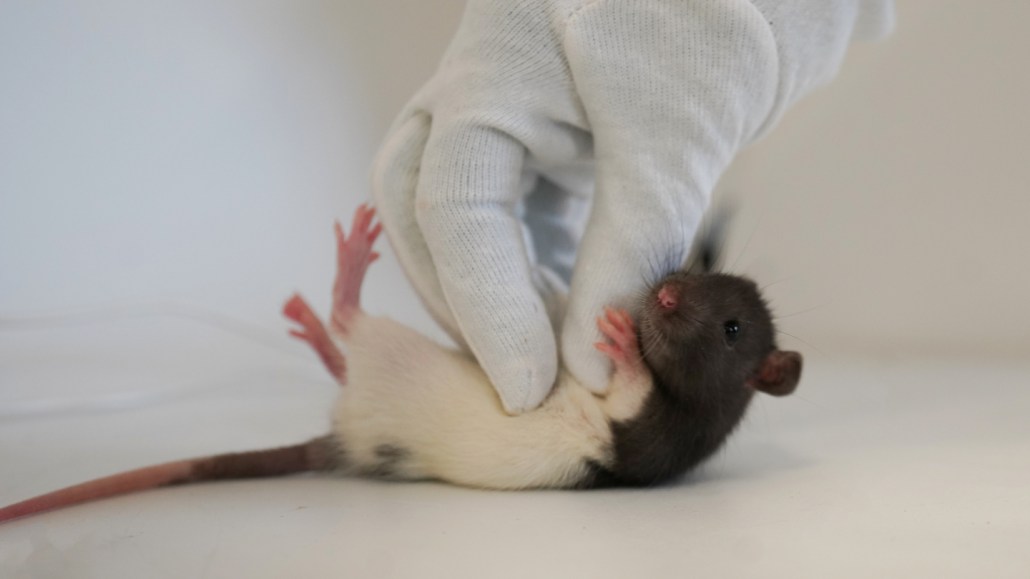Playful behavior in rats is controlled by a specific area of their brains
Studying this brain circuitry may lead to insights into human mood disorders

Rats are known for their playful behavior. By tickling rats and playing chase-the-hand with them, researchers zeroed in on a brain region that activates when rats play.
Natalie Gloveli
By Simon Makin
- More than 2 years ago
Read another version of this article at Science News Explores
Rats are extremely playful creatures. They love playing chase, and they literally jump for joy when tickled. Central to this playfulness, a new study finds, are cells in a specific region of rats’ brains.
Neurons in the periaqueductal gray, or PAG, are active in rats during different kinds of play, scientists report July 28 in Neuron. And blocking the activity of those neurons makes the rodents much less playful.
The results give insight into a poorly understood behavior, particularly in terms of how play is controlled in the brain. “There are prejudices that it’s childish and not important, but play is an underrated behavior,” says Michael Brecht, a neuroscientist at Humboldt University in Berlin.
Scientists think play helps animals develop resilience. Some even relate it to optimal functioning. “When you’re playing, you’re being your most creative, thoughtful, interactive self,” says Jeffrey Burgdorf, a neuroscientist at Northwestern University in Evanston, Ill., who was not involved in the new study. This is the opposite of depressive states, and Burgdorf’s own research aims to turn understanding the neuroscience of play into new therapies for mood disorders.
For the new study, Brecht and colleagues got rats used to lab life and being tickled and played with in a game of chase-the-hand. When rats play, they squeal with glee at a frequency of 50 kilohertz, which humans can’t hear. The researchers recorded these ultrasonic giggles as a way of measuring when the rats were having fun.
Brecht and colleagues suspected the PAG — a deep, midbrain region connecting the forebrain to the lower brainstem that’s involved in many automatic functions and instinctual responses — might be involved in play behavior, partly because it controls these vocalizations. If your playmate stops laughing, it is time to stop play-fighting.
The team recorded activity from individual cells in rats’ PAGs while they played chase-the-hand or were tickled. Cells located in two columns down the sides of the PAG were active during play, the researchers found. “These cells really go crazy, especially in response to tickling,” Brecht says. Importantly, the same cells were active during both chasing and tickling. “This was where we thought: These are the cells,” Brecht says. “They’re not about moving, or touch. They’re about fun.”
Making the rats anxious by putting them on an elevated, brightly lit platform suppressed playfulness and giggles, and reduced activity in these “fun” cells.
The researchers then genetically altered the cells so they could be turned off using light. Blocking activity in just these cells caused the rats to play much less and become less ticklish, as shown by an absence of giggles, the team found.
These results suggest that the PAG is required for play, probably as part of a circuit. Brecht and colleagues have previously found play-responsive neurons in the somatosensory cortex, a brain region responsible for perceiving touch (SN: 11/10/16). However, other research has shown that animals without a cortex still play. Brecht doesn’t think the same will be true for animals lacking the play-associated part of the PAG. “We think it’s a control structure for playfulness.”
Understanding this circuitry better may help researchers improve their knowledge of depression in people (SN: 2/12/23). “The people that really, really need help are the ones that can’t play,” Burgdorf says. The new study is a step toward understanding what that looks like in the brain, which could one day help clinicians choose the best treatments for different patients, Burgdorf says.
The team plans to study this region in other animals to see how it might differ across species and to see if it helps explain why some animals are more playful than others, Brecht says. One of the first things Brecht did after realizing its importance in rats was look at the region in humans. “And guess what? It’s very large,” he says. “That’s not a coincidence: No animal plays as many games as we do.”






